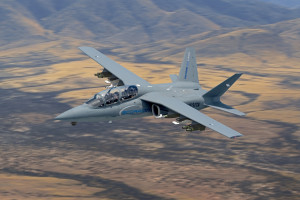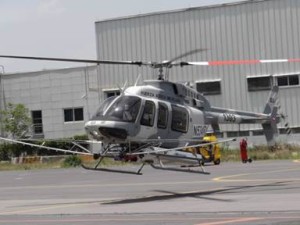Saab to Provide Wide Area Multilateration Systems at Cucuta and Medellin in Colombia
March 31, 2016
Defence and security company Saab announces that it has been awarded a contract to deploy Wide Area Multilateration (WAM) surveillance systems around the cities of Cucuta and Medellin for Aeronáutica Civil de Colombia (Aerocivil).
Saab will be working with its local Colombian partner, Entelcom S.A.S., to install an array of its latest multilateration and ADS-B ground stations to provide surveillance of the Cucuta and Medellin approach sectors. ADS-B is the next generation of aircraft surveillance, which utilizes global navigation satellite systems to track aircraft positions. Saab’s system will improve the safety of flights operating in the visual corridor between Enrique Olaya Herrera Airport (SKMD) and José María Córdova International Airport (SKRG). Saab’s field-proven technology provides coverage in areas that are infeasible to reach with traditional radar.
“Saab’s multilateration and ADS-B solutions provide air navigation service providers like Aerocivil with the critical surveillance they need while costing much less than radar-based solutions” explains Anders Carp, Head of Saab Traffic Management.
Saab is the leading multilateration surveillance provider in the world and is responsible for more than half of all global installations. Saab provides the global defence and aviation markets with advanced sensor technologies, next-generation radars, ATC automation tools, and collaborative decision-making and efficiency solutions. It serves military, civil aviation, airport and airline customers in more than 40 countries across six continents.
Colombian Air Force Increases Mission Capability with Acceptance of Seventh Bell Helicopter Huey II Kit
March 30, 2016
FIDAE – Santiago, Chile (March 30, 2016) – Bell Helicopter, a Textron Inc. (NYSE: TXT) company, announced today that the Colombian Air Force (COLAF) had accepted their seventh Huey II Kit – continuing to improve their fleet performance and mission readiness.
The delivery of the Huey II Kit is a part of an ongoing upgrade program designed to revitalize the Colombian Air Force’s UH-1H fleet. The upgrade allows for multiple configurations and increased overall mission capability.
“The Huey II upgrade reduces direct maintenance costs (DMCs), improves performance and enhances safety,” said Bob Poindexter, Huey II Customer Support and Services Program Manager for Bell Helicopter. “With more than 270 aircraft built, the Huey II is the only OEM approved UH-1H upgrade currently available.”
In addition to improved aircraft performance, the Huey II upgrade program has allowed for increased capabilities of COLAF maintenance personnel. COLAF’s ability to work directly with Bell Helicopter’s onsite support throughout the initial conversion process has allowed maintenance personnel to develop a broader understanding of the Huey II structural and maintenance differences from the UH-1H.
“The program began with an onsite full-time Bell Helicopter technical representative supporting the in-country upgrade program for the initial Huey II conversion,” added Poindexter. “Following the initial upgrade, COLAF has been completing all conversions. The program overall allows for the increased fleet longevity and better cost oversight and forecasting.”
Bell Helicopter provides its customers with local support in every corner of the world and has the largest support network in the industry with more than 100 Authorized Customer Service Facilities in 34 countries. Ranked number one in customer support by Professional Pilot magazine for 22 consecutive years, Bell Helicopter is committed to having resources where customers operate to speed up delivery of service and support, and give customers access to service professionals that are easy to reach, know the operating environment and understand their needs.
Fleet in Latin America to more than double by 2034
March 30, 2016
Long-term forecast sees resilience, sound growth potential for aviation in the region
According to the latest Airbus Global Market Forecast (GMF), Latin America will need 2,540
new passenger and freighter aircraft between 2015 and 2034, to meet long term growth in the
region. This demand includes 1,990 single-aisle and 550 widebody like the A330, A3350 XWB
and A380, worth an estimated US$330 billion. This demand will mean that the passenger and
freighter fleet operated by the regions airlines will more than double to nearly 3,000 aircraft in
the next 20 years. Today, 53 percent of Latin America’s in-service fleet are Airbus aircraft
operated by the region’s leading carriers. This includes the Americas’ first A350 XWB, delivered
to LATAM Airlines Group in January, operated by TAM.
Latin America’s traffic will grow at an average of 4.7 percent annually in the next 20 years,
above the world average of 4.6 percent. Driving this growth are airlines domiciled in the region
growing at 5.0 percent annually, placing them among the world’s top three fastest-growing
group of airlines.
The region’s urbanization is a factor propelling this growth, as Latin America is one of the most
urbanized in the world second only to North America, with some 80 percent of its population
living in cities. A consistent economic growth will also prompt traffic growth in the region;
according to the GMF, in the next 20 years, Latin America’s annual GDP is forecast to grow at a
rate of 3.6 percent, above the world’s 3.2 percent. Furthermore, Latin American passengers will
play a part in fueling traffic growth, taking on average over twice as many flights by 2034 as
they do now.
“Latin America’s long-haul route expansion is imminent, and we are already seeing airlines
respond by opting for larger, longer-range and more efficient aircraft such as the A350 XWB
and the A380, which both began operating in the region in 2016,” said Rafael Alonso, President
of Airbus for Latin American and the Caribbean. “We are also seeing the region’s top airlines
modernizing their fleets with the A320neo Family, allowing them to achieve efficiency gains
even in a less-than-favorable economic environment.”
While presenting the Airbus Global Market Forecast for Latin America during a press
conference at Chile’s FIDAE (Feria Internacional del Aire y del Espacio) Air Show, Alonso
added, “By 2034 we will see nine of the world’s 91 megacities located in Latin America,
including Santiago, making it a world-leading emerging aviation market. In the long-term, we are
optimistic about the outlook for Latin America as it expands its aviation footprint on the world’s
stage.”
Presently, the long-haul market space presents a solid opportunity for Latin American carriers to
claim back market share. Today, the top European and North American airlines carry the
majority of long-haul traffic into and out of the region, at 83 percent and 75 percent respectively.
In fact, according to the GMF, the traffic flows between South America and Western Europe and
between South America and the United States are forecast to be two of the world’s largest
international traffic flows by 2034.
Similarly, the intra-regional and domestic market within Latin America also holds tremendous
growth potential given that traffic is expected to nearly triple in the next 20 years, growing at a
favorable rate of 5.3 percent. Passengers in North America and Europe can count on at least
one flight per day to connect them to the 20 largest cities in their regions, but in Latin America this figure is smaller. Only 43 percent of the region’s top 20 cities are connected by one daily
flight, leaving the rest of the region’s cities with less-than-weekly connections or none at all.
The region’s low cost carriers (LCC) have grown tremendously in the past 15 years, accounting
for only 10 percent of air traffic in Latin America in 2003 to almost 40 percent today. Previously
concentrated exclusively in Brazil and Mexico, the LCC model has emerged in other key
markets like Colombia and Chile.
With nearly 1,000 aircraft sold and a backlog of more than 400, over 600 Airbus aircraft are in
operation throughout Latin America and the Caribbean. Since 1990, Airbus has secured 63
percent of net orders in the region and in the past 10 years alone, Airbus has tripled its inservice
fleet.
La flota de aviones en Latinoamérica se duplicará con creces de aquí a 2034
March 30, 2016
La previsión a largo plazo apunta a un importante potencial de crecimiento de la
aviación en la región
Según la última Previsión Global del Mercado (GMF) de Airbus, América Latina necesitará
2.540 nuevos aviones de pasajeros y carga entre 2015 y 2034 para atender el crecimiento a
largo plazo en la región. Esta demanda comprende 1.990 aviones de pasillo único y 550 de
cabina ancha como el A330, A350 XWB y A380, por un valor estimado de 330.000 millones de
dólares. Dicha demanda significa que la flota de aviones de pasajeros y de carga operados por
las compañías aéreas de la región se duplicará ampliamente hasta llegar a cerca de 3.000
aviones en los próximos 20 años. Hoy, el 53 por ciento de la flota en servicio de América Latina
está constituido por aviones Airbus operados por las principales aerolíneas de la región. Esto
incluye el primer A350 XWB del continente americano, entregado a LATAM Airlines Group en
enero y operado por TAM.
El tráfico latinoamericano crecerá a una media del 4,7 por ciento anual a lo largo de los
próximos 20 años, por encima de la media mundial del 4,6 por ciento. A la cabeza de este
crecimiento se sitúan las compañías aéreas domiciliadas en la región, que crecerán a un ritmo
del 5 por ciento anual, lo que las coloca entre los tres grupos de aerolíneas de más rápido
crecimiento del mundo.
El desarrollo urbanístico de la región es uno de los factores que está impulsando este
crecimiento, siendo América Latina una de las regiones de mayor tasa de urbanización del
mundo, solo por detrás de América del Norte, y con un 80 por ciento de su población viviendo
en ciudades. Un crecimiento económico sostenido estimulará también el crecimiento del tráfico
en la región; según el GMF, en los próximos 20 años el PIB anual de América Latina crecerá a
un ritmo del 3,6 por ciento, superior a la tasa mundial del 3,2 por ciento. Los pasajeros
latinoamericanos tendrán además un papel protagonista en el crecimiento del tráfico,
duplicando por término medio el número de vuelos que realizan en la actualidad, de aquí al
2034.
“La expansión de las rutas de largo recorrido en América Latina es inminente, y estamos ya
viendo a algunas compañías aéreas reaccionar optando por aviones más grandes, más
eficaces y de mayor autonomía como el A350 XWB y el A380, que empezaron a operar en la
región en 2016,” afirma Rafael Alonso, presidente de Airbus para América Latina y el Caribe.
“También estamos viendo a las aerolíneas más importantes de la región modernizar sus flotas
con la Familia A320neo, lo que les permite aumentar su eficiencia incluso en un entorno
económico no muy favorable.”
Durante su presentación de la Previsión Global del Mercado de Airbus para Latinoamérica en
una rueda de prensa con motivo del salón aeronáutico FIDAE (Feria Internacional del Aire y del
Espacio) de Chile, Rafael Alonso añadió: “Para el año 2034 veremos como nueve de las 91
megaciudades del mundo son de América Latina, incluida Santiago, convirtiendo a la región en
uno de los mercados aéreos emergentes más importantes a escala internacional. A largo plazo,
somos optimistas sobre las perspectivas para América Latina en la medida en que esta está
ampliando su huella en el sector aéreo a nivel mundial.”
Helicópteros de Rusia cumplió el primer contrato con Fuerzas Navales de México
March 29, 2016
- Helicópteros de Rusia realiza el servicio de garantía y post garantía de los 19 helicópteros de la Secretaría de Defensa Nacional.
- “México es uno de los socios claves en América Latina que usa una flota bastante amplia de los helicópteros de la producción rusa” dijo el vicedirector general de holding Helicópteros de Rusia Igor Chéchikov.
- Las características de los Mi-17 y el multiuso Mi-171B hicieron a estos helicópteros muy populares en todo el mundo.
México D.F, 29 de Marzo, 2016: El holding “Helicópteros de Rusia”, parte integrante de Rostec, cumplió con el contrato de servicio post-venta de los helicópteros multiuso Mi-17-1B que se usan por las Fuerzas Navales de México.
“Este es el primer contrato con la Secretaría de Marina de México. Dicho contrato está realizado en tiempo y forma”, dijo el vicedirector general de holding Helicópteros de Rusia Igor Chéchikov. “México es uno de los socios clave en América Latina el cual usa una flota bastante amplia de los helicópteros de fabricación rusa. Estamos esperando este 2016 la ampliación de la colaboración con nuestros socios mexicanos en el marco de servicio post-venta y fortalecimiento de nuestra interacción. Ya estamos en el proceso de negociaciones correspondientes” concluyó Chéchikov.
Una de las prioridades del holding es el desarrollo del sistema integral del servicio post-venta de los helicópteros de la producción rusa en todo el mundo para ampliar la red global de mantención técnica. Helicópteros de Rusia planea la creación de los centros de servicio en el territorio de varios países de América Latina.
En 2014-2015 el holding colaboraba con éxito con la Secretaría de la Defensa Nacional de México para realizar la reparación capital de 19 helicópteros Mi-17/Mi-17-1B. Ahora, Helicópteros de Rusia realiza de una forma dinámica, el servicio de garantía y post garantía de los helicópteros de la Secretaría de Defensa Nacional.
El helicóptero multiuso Mi-171B es una de las modificaciones de la familia de helicópteros Mi-17 diseñados por la fábrica de helicópteros de Moscú Mil del holding Helicópteros de Rusia. Las características de altas técnicas y de vuelo, su simpleza en el uso y la solidez, hicieron a estos helicópteros muy populares en todo el mundo. El multiuso Mi-171B es capaz de desarrollar la velocidad hasta 250 kilómetros por hora, mientras que su longitud de vuelo es 610 kilómetros. Mi-17-1B es capaz de llevar hasta 37 personas de desembarque.
Scorpion Jet makes FIDAE International Air and Space Fair debut
March 29, 2016
SANTIAGO, Chile (March 29, 2016) – Textron AirLand, LLC, a Textron Inc. (NYSE:TXT) company, today announced the Scorpion Jet is making its show debut this week at the FIDAE International Air and Space Fair.

�
�
�
�
�
�
�
�
“Textron AirLand’s Scorpion is a bold new direction for tactical aircraft and its debut at FIDAE gives us the opportunity to showcase the Scorpion’s flexible multi-mission capabilities to a diverse set of international militaries,” said Bill Anderson, president, Textron AirLand. “The Scorpion is a tactical aircraft that delivers high-end capabilities and performance at a price that completely reverses the rising cost curve that challenges even the most affluent nations to build and sustain their air forces.”
In two years of flight operations, the Scorpion has self-deployed to ten countries, participated in military training exercises and operations, flown numerous U.S. and international military pilots and amassed nearly 600 flight hours. The Scorpion has accomplished all of this with an exceptional availability rating of over 98 percent and a comprehensive cost per flight hour below $3,000, including consumables, system/engine reserves and labor. Using commercial practices, leading edge design technologies and world-class workforce and facilities of Textron Aviation, the Scorpion progressed from a clean-sheet design to first flight in less than 24 months, making it one of the fastest developments of a U.S.-built tactical jet. The first production aircraft is expected to make its first flight this summer, and will be available for prospective customer flights and evaluations soon after.
The Scorpion’s modular architecture provides the capability to rapidly reconfigure mission payloads, including sensors and weapons, enabling one aircraft to master diverse missions yielding significant acquisition cost savings, operation flexibility, reduced logistics footprint and training benefits. The Scorpion excels in many roles, including armed reconnaissance, maritime control, close air support, intermediate and advanced jet training, strike, and intelligence, surveillance and reconnaissance for humanitarian assistance and disaster relief.
Cessna Citation Latitude makes FIDAE International Air and Space Fair debut
March 29, 2016
SANTIAGO, Chile (March 29, 2016) – Cessna Aircraft Company, a subsidiary of Textron Aviation Inc, a Textron Inc. (NYSE:TXT) company, today announced that the Cessna Citation Latitude is making its FIDAE International Air and Space Fair debut at the Santiago International Airport March 29-April 3. The Latitude, Textron Aviation’s most recently certified business jet, has been on a wordwide tour demonstrating its performance capabilities and class-leading cabin experience.
“The Latitude is already garnering strong interest from the Latin American market, offering customers our most spacious cabin environment and best-in-class operating costs,” said Bob Gibbs, regional vice president of Sales for Latin America and Caribbean. “We are the clear leaders in the Latin American jet market, with over 800 Citations and growing. The addition of the Latititude will only strengthen the Textron Aviation fleet and support the business aviation needs in this region.”
Textron Aviation expands sales relationship with Chilean representative Aviasur
March 29, 2016
SANTIAGO, Chile (March 29, 2016) – Textron Aviation Inc., a Textron Inc. (NYSE:TXT) company, today announced it has expanded its sales relationship with Aviasur NZ Limited Partnership (Aviasur) to include Cessna products. With this appointment, Santiago based Aviasur now offers the complete Beechcraft and Cessna product lines to the Chilean market.
“Aviasur has proven to be a strong partner for Textron Aviation,” said Bob Gibbs, regional vice president of Sales, Latin America and Caribbean. “Their reputation for providing excellent customer support will bring added value to our customers in the region as Aviasur’s offerings now represent both the Beechcraft and Cessna product lines.”
Aviasur has supported Beechcraft products as an authorized sales representative for over five years and an authorized service facility since 2012, providing quality customer support and service to the growing number of Textron Aviation customers in Chile.
Textron Aviation continues to lead in the Latin America jet market with over 800 Citation products in the region. As Aviasur continues to grow and strengthen the Textron Aviation fleet they can now offer the Cessna Citation Latitude, which offers customers a spacious and refined cabin environment, as well as the Cessna Citation M2, the perfect fit for owner pilots. Both aircraft are on display at the FIDAE International Air and Space Fair this week.
Russian Helicopters fulfills first contract with the Mexican Secretariat of the Navy
March 29, 2016
Russian Helicopters fulfills first contract with the Mexican Secretariat of the Navy
Moscow / March 29, 2016
Russian Helicopters, part of State Corporation Rostec, has fulfilled its first contract for after-sale maintenance of multirole Mi-17-1V helicopters operated by the Mexican Navy.
“This is our first contract with the Naval Secretariat of Mexico. It was fulfilled in full and on time,” said Igor Chechikov, Russian Helicopter’s deputy CEO. “Mexico is one of our key partners in Latin America; it has quite an extensive fleet of Russian-made helicopters. In 2016, we will expand cooperation with our Mexican partners in terms of after-sale service. The parties are already involved in negotiations on these issues.”
One of the main priorities for Russian Helicopters is active development of a comprehensive system of after-sales service for Russian-made helicopters all around the world including a number of Latin American countries.
In 2014-2015, the company successfully collaborated with the Mexican Secretariat of National Defense by performing extensive repairs of 19 Mi-17/Mi-17-1V helicopters. Currently, Russian Helicopters are actively involved in warranty and post-warranty maintenance of helicopters belonging to the Mexican Ministry of Defense.
The multirole Mi-171V helicopter is one of the modifications of the Mi-17 series that were developed by Mil Moscow Helicopter Plant, part of Russian Helicopters. Strong flight performance, simplicity of operation and reliability made these helicopters popular all around the world. The multirole Mi-171V helicopter is capable of moving at a speed of 250 km per hour and its flying range is 610 km. The helicopter is capable of transporting up to 37 troopers.
FIDAE is the most important aerospace industry exhibition in Latin America, it is held biennially in Santiago (Chile).
Russian Helicopters, (part of State Corporation Rostec), is one of the global leaders in helicopter production and the only helicopter design and production powerhouse in Russia. Russian Helicopters was founded in 2007 and is headquartered in Moscow. The company comprises five helicopter production facilities, two design bureaus, a spare parts production and repair facility, as well as an aftersale service branch responsible for maintenance and repair in Russia and all over the world. Its helicopters are popular among Russian ministries and state authorities (Ministry of Defence, Ministry of Internal Affairs, Emergency Control Ministry), operators (Gazpromavia, UTair), major Russian corporations. In 2014 its IFRS revenues increased 22,8% to RUB 169,8 billion. Deliveries reached 271 helicopters.
State Corporation Rostec is a Russian corporation founded in 2007 for the purpose of promoting the development, production and export of hi-tech civilian and military industry products. It comprises 700 organisations, nine of which have now been formed as holding companies of the military-industrial complex, five of them are involved in civil industries and 22 are directly controlled. Rostec’s portfolio includes recognised brands such as Avtovaz, Kamaz, Russian Helicopters, and VSMPO-AVISMA. Rostec’s organisations are located in 60 constituent entities of the Russian Federation and supply their products to the markets of more than 70 countries. The revenue of Rostec in 2014 amounted to RUB 964.5 billion. The tax deductions into the treasuries at all levels exceeded RUB 147.8 billion.
Bell Helicopter Delivers 15th Bell 407GXP to Mexican Air Force
March 29, 2016
Santiago, Chile (March 28, 2016) Bell Helicopter, a Textron Inc. (NYSE: TXT) company, announced today the final delivery of the 15th Bell 407GXP to the Mexican Air Force (FAM). The contract was awarded in March 2015, and the Bell 407GXP fleet is currently supporting the FAM’s parapublic missions across the region.
As the primary aircraft operating branch of the Mexican Armed Forces, the FAM covers the entire country, with 18 military air bases located across Mexico. The FAM have been operating Bell helicopters since 1973 with the delivery of a Bell 206-B, and their fleet currently includes the Bell 412EP, 212 and 206. The 15 Bell 407GXPs are operated by the 111th Air Squadron based at the Military Airbase in Zapopan, Jalisco.

�
�
�
�
�
�
“The Bell 407GXP is truly a multi-mission capable platform that can perform various missions at superior standards,” said Jay Ortiz, vice president of Latin American sales. “We are honored by the Mexican Air Force’s trust in Bell Helicopter and our aircraft, and we are proud to have delivered the final Bell 407GXP to join their fleet.”
With more than 1,300 Bell 407 aircraft operating worldwide, there are more than 200 in parapublic configuration. The Bell 407 platform remains a popular aircraft among Bell Helicopter’s parapublic agencies operating Bell aircraft.
Bell Helicopter has a rich history in Mexico, which started more than 50 years ago with the delivery of the first aircraft to the region. Bell Helicopter’s footprint spans two Customer Service facilities, in addition to the manufacturing facility based in Chihuahua and the new addition of the sales office in Mexico City. Bell Helicopter’s parent company, Textron, also maintains six additional service and manufacturing facilities throughout the country.
The Bell 407GXP is another example of Bell Helicopter’s continued investment in its current products to enhance customer value and increase mission capability. The Bell 407GXP is an upgrade to Bell Helicopter’s best-selling platform, the Bell 407, with added value through industry leading performance, payload capability and operating economics.
<






